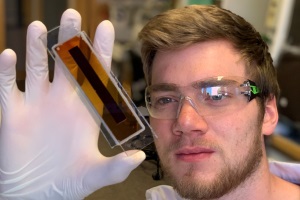Ambient light could power IoT artificial intelligence in the home

Ultra-efficient photovoltaics that work indoors could make charging mobile devices, plugging in routers and putting batteries in remote controls all history.
Rather than relying on direct rays from the sun, the new photovoltaic panels generate electricity by converting ambient light – such as from indoor lightbulbs – into electricity. This can be ideal for some low power wireless and smart devices.
Publishing their findings in the Royal Society of Chemistry journal Chemical Science, a team led by Dr Marina Freitag at Newcastle University, UK, and the Uppsala University, Sweden, has enhanced conventional solar panel design.
The team is using a combination of dyes to focus the panels purely on artificial light. These panels are then applied to sensors which measure functions in a similar way to smart watches or indoor thermostats, allowing them to operate without a connected power source.
Dr Freitag says: “The dyes we use allows us to focus the photovoltaic on the visible spectrums of light, as we don’t have to worry about ultraviolet or infrared light, for example. They can also be used outdoors, but they’re most effective inside. When you combine that with Internet of Things (IoT) and artificial intelligence (AI), they can operate independent of wires and batteries – making them far more sustainable.
“There are a number of different uses for this. I have been working on prototypes for automated liquid dispensers, to low maintenance building monitoring through IoT, for example monitoring for temperature or structural integrity. Rather than having cables everywhere, powering these devices can be done with the flick of the light switch,” she adds.
Dr Freitag’s team showed that integrating artificial intelligence and machine learning with engineering allowed devices to maximise efficiency by understanding when the best light will be available.
And as light varies through the day, the devices would be able to hold back on intensive activities, such as installing updates, for when available light is at its brightest.

The research is seen as crucial to the ongoing development of devices for the Internet of Things – smart devices that connect to the internet to help us in our daily lives. Ranging from smart doorbells and connected lightbulbs to smart watches and smart speakers, it is estimated we have 20 billion such devices in our homes already. However, with forecasts suggesting we’ll add 55 billion more to our homes by 2025, Dr Freitag hopes her innovation can actually reduce the number of required devices and batteries.
“To have 75 billion devices is an incredible number,” comments Dr Freitag. “Having a number of smartly-powered sensors that can communicate to each other is surely preferable to having lots of devices each with their own batteries. Ultimately, this could eliminate the need for batteries and make IoT sustainable in the future.”
Executive editor at the Royal Society of Chemistry, May Copsey says: “Chemistry research like this – which we could see in every home in the world one day – is what makes working on our flagship journal Chemical Science incredibly exciting.
“In an age where we increasingly have a network of smart, connected devices in our homes, just imagine the implications for reducing global energy consumption if an entirely untapped energy source can be used. Aside from this, simply not having to connect the increasing number of gadgets in our home to the socket on the wall will save a lot of frustration with tangled wires or the need for recycling of batteries,” Copsey concludes.
The research was the result of a cross-discipline collaboration comprising machine learning expert, Alessio Gagliardi of the Technical University of Munich, IoT expert Richard Freitag, Uppsala University, and world-renowned expert in AI, Richard Socher of Salesforce.
For more information click here
Comment on this article below or via Twitter @IoTGN.
